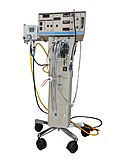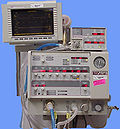Mechanical ventilation
Mechanical Ventilation is a method to assist or replace spontaneous breathing. This can be a life-saving intervention, but can also cause complications and side effects. Mechanical ventilation is often used in intensive care units, home care, and emergency medicine.
Indications[edit]
Mechanical ventilation is indicated when the patient's spontaneous breathing is inadequate to maintain life. It can also be used to sedate the patient for a short period of time, such as during the operation of a ventilator, or during recovery from a critical illness. The main indications for mechanical ventilation are:
- Acute lung injury including Acute Respiratory Distress Syndrome (ARDS)
- Chronic Obstructive Pulmonary Disease (COPD)
- Neuromuscular disease or weakness
- Drug overdose
- Anesthesia
- Sedation
- Coma
Modes[edit]
There are two main modes of mechanical ventilation: Positive Pressure Ventilation and Negative Pressure Ventilation.
Complications[edit]
Complications of mechanical ventilation are mainly related to the method of ventilation and the duration of ventilation. They include:
- Ventilator-associated pneumonia (VAP)
- Barotrauma
- Oxygen toxicity
- Right ventricular failure
- Pulmonary embolism
- Acute Respiratory Distress Syndrome (ARDS)
Weaning[edit]
Weaning is the process of gradually reducing the degree of mechanical ventilation and allowing the patient to resume spontaneous breathing. This can be a complex process and is usually managed by a team of healthcare professionals.
See also[edit]
Ad. Transform your life with W8MD's Budget GLP-1 injections from $75


W8MD offers a medical weight loss program to lose weight in Philadelphia. Our physician-supervised medical weight loss provides:
- Weight loss injections in NYC (generic and brand names):
- Zepbound / Mounjaro, Wegovy / Ozempic, Saxenda
- Most insurances accepted or discounted self-pay rates. We will obtain insurance prior authorizations if needed.
- Generic GLP1 weight loss injections from $75 for the starting dose.
- Also offer prescription weight loss medications including Phentermine, Qsymia, Diethylpropion, Contrave etc.
NYC weight loss doctor appointmentsNYC weight loss doctor appointments
Start your NYC weight loss journey today at our NYC medical weight loss and Philadelphia medical weight loss clinics.
- Call 718-946-5500 to lose weight in NYC or for medical weight loss in Philadelphia 215-676-2334.
- Tags:NYC medical weight loss, Philadelphia lose weight Zepbound NYC, Budget GLP1 weight loss injections, Wegovy Philadelphia, Wegovy NYC, Philadelphia medical weight loss, Brookly weight loss and Wegovy NYC
|
WikiMD's Wellness Encyclopedia |
| Let Food Be Thy Medicine Medicine Thy Food - Hippocrates |
Medical Disclaimer: WikiMD is not a substitute for professional medical advice. The information on WikiMD is provided as an information resource only, may be incorrect, outdated or misleading, and is not to be used or relied on for any diagnostic or treatment purposes. Please consult your health care provider before making any healthcare decisions or for guidance about a specific medical condition. WikiMD expressly disclaims responsibility, and shall have no liability, for any damages, loss, injury, or liability whatsoever suffered as a result of your reliance on the information contained in this site. By visiting this site you agree to the foregoing terms and conditions, which may from time to time be changed or supplemented by WikiMD. If you do not agree to the foregoing terms and conditions, you should not enter or use this site. See full disclaimer.
Credits:Most images are courtesy of Wikimedia commons, and templates, categories Wikipedia, licensed under CC BY SA or similar.
Translate this page: - East Asian
中文,
日本,
한국어,
South Asian
हिन्दी,
தமிழ்,
తెలుగు,
Urdu,
ಕನ್ನಡ,
Southeast Asian
Indonesian,
Vietnamese,
Thai,
မြန်မာဘာသာ,
বাংলা
European
español,
Deutsch,
français,
Greek,
português do Brasil,
polski,
română,
русский,
Nederlands,
norsk,
svenska,
suomi,
Italian
Middle Eastern & African
عربى,
Turkish,
Persian,
Hebrew,
Afrikaans,
isiZulu,
Kiswahili,
Other
Bulgarian,
Hungarian,
Czech,
Swedish,
മലയാളം,
मराठी,
ਪੰਜਾਬੀ,
ગુજરાતી,
Portuguese,
Ukrainian










